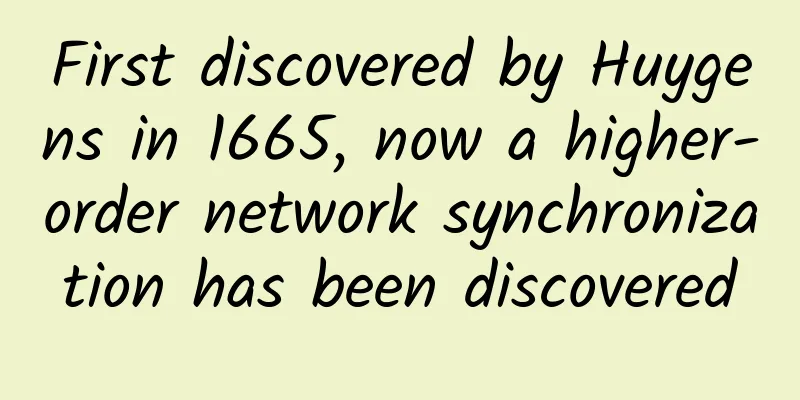First discovered by Huygens in 1665, now a higher-order network synchronization has been discovered

|
A study led by Queen Mary University of London has proposed for the first time a novel 'higher-order' Kuramoto model that combines topology with dynamical systems and characterises synchronization in higher-order networks. Just like an orchestra playing in time without a conductor, elements of a complex system can naturally synchronise with each other. This collective phenomenon, known as synchronization, occurs throughout nature, from neurons firing together in the brain to fireflies flashing in unison in the dark. The Kuramoto model is used to study synchronization observed in complex systems, which are often represented mathematically by networks, where the components in the system are represented as nodes and the links between the nodes represent the interactions between them. Most studies of synchronization have focused on networks, where nodes host dynamical oscillators that behave like clocks and couple to their neighbors along the links of the network. However, the vast majority of complex systems have richer structure than networks and include "higher order" interactions that occur between more than two nodes. These higher-order networks are called simplicial complexes and have been extensively studied by mathematicians in discrete topology. Now, research led by Professor Ginestra Bianconi, Professor of Applied Mathematics at Queen Mary University of London, has proposed a novel "higher-order" Kuramoto model that combines topology with dynamical systems to characterize synchronization in higher-order networks for the first time. The study found that higher-order synchronization occurs suddenly, in an "explosive" way, which is different from the standard Kuramoto model, where synchronization occurs gradually. Mathematician Christian Huygens first discovered synchronization in 1665 when he observed two pendulum clocks suspended from the same wooden beam swinging in time with each other. However, it wasn't until 1974 that Japanese physicist Yoshiki Kuramoto proposed a simple mathematical model to describe this collective phenomenon. Kuramoto's model captures synchronization in a large network in which each node possesses a clock-like oscillator that couples to other oscillators at neighboring nodes. In the absence of links between nodes, each oscillator follows its own dynamics and is not influenced by its neighbors. However, when the interaction between neighboring nodes switches above a given value, the oscillators begin to beat at the same frequency. While the Kuramoto model describes the dynamical synchronization associated with network nodes in a pure complex, higher-order objects in the network (such as links or triangles) can also exhibit dynamical or "topological" signals such as fluxes. In the new study, the researchers proposed a higher-order Kuramoto model that can describe the synchronization of these topological signals. Since topological signals such as flux can be found in the brain and in biological transport networks, the researchers believe that this new model may reveal higher-order synchronization that had not been noticed before. Professor Bianconi, the lead author of the study, said: "The study combines Hodge theory, an important branch of topology, with the theory of dynamical systems to shed light on higher-order synchronization. Using the theoretical framework, it is possible to treat synchronization of topological dynamic signals associated with connections, such as flux, or synchronization with triangles or other higher-order building blocks of higher-order networks. These signals can be synchronized, but this synchronization may be overlooked if the correct topological transformation is not performed." The new study proposes a Fourier transform equivalent to a topological signal that can reveal this. The discontinuous transitions found in the study also show that the synchronization phenomenon is not only spontaneous but also emerges suddenly, revealing how topology causes a drastic change in dynamics at the beginning of the synchronization transition. Boco Park | Research/From: Queen Mary University of London |
<<: This letter from Beijing made Awa Mountain boil!
Recommend
Is it possible that some super theory will emerge in the future that will cause existing physical theories to collapse?
This article is based on answering similar questi...
In a blink of an eye, crayfish shells have been transformed from "kitchen waste" into "little experts" in capturing microplastics!
Author: Shi Xiangqi and Li Chuanfu Microplastic p...
Launch a rocket to welcome the Spring Festival! If you want to understand the Land Exploration No. 1 Group A, you need to know these keywords
Your browser does not support the video tag Video...
What should you do if your phone falls on the subway tracks? First, don’t jump!
A netizen once asked sincerely, why are more and ...
How much does a mini program server cost per year? Do I need to purchase a server to develop a mini program?
Nowadays, the number of registered users of WeCha...
Drinking hydrogen water, breathing hydrogen gas, taking hydrogen baths... can it really cure all diseases?
gossip Drinking hydrogen water, inhaling hydrogen...
How to optimize advertising creatives to increase efficiency by 50%?
“It is important to have a teacher in learning, b...
In ancient times, fishtail copper tiles were used to prevent lightning, and today there are "lightning-absorbing artifacts": Why is China's lightning protection technology leading the world?
“The storm is coming” and “the dark clouds are pr...
Taobao operation: How to use Weitao to improve conversion rate?
Since Taobao was redesigned and the Weitao sectio...
With the recent cold waves, it’s time for the “hot” rumors in December to fade away
At the end of the year, the rumors that have been...
What should I do if I encounter negative reviews in the Apple App Store? Use these 6 methods to help you solve the problem!
Those who do operations are afraid of encounterin...
GSMA: 50% of Chinese consumers hope to buy 5G mobile phones as soon as possible
Smartphones will remain the dominant consumer dev...
Why are there so many different flight configurations for helicopters? What are their characteristics?
Compared with fixed-wing aircraft, helicopters ca...
Air travel will not return to normal until 2024. How much damage will the epidemic cause to the aviation industry?
Air travel won't return to normal until 2024 ...









